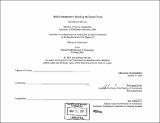| dc.contributor.advisor | Wellington Reiter. | en_US |
| dc.contributor.author | McLean, David Bruce, 1975- | en_US |
| dc.contributor.other | Massachusetts Institute of Technology. Dept. of Architecture. | en_US |
| dc.date.accessioned | 2005-09-26T19:27:07Z | |
| dc.date.available | 2005-09-26T19:27:07Z | |
| dc.date.copyright | 2003 | en_US |
| dc.date.issued | 2003 | en_US |
| dc.identifier.uri | http://hdl.handle.net/1721.1/28265 | |
| dc.description | Thesis (M.Arch.)--Massachusetts Institute of Technology, Dept. of Architecture, 2003. | en_US |
| dc.description | Includes bibliographical references (leaves 82-83). | en_US |
| dc.description.abstract | The concept of the digital divide is a condition in the urban context where informationalization via computer technology exacerbates a duality that consists of those who have access to information technologies, and those who do not. The resultant outcome is a marginalized community left behind - a polarized urban system socially, spatially, and technologically. Low-income communities become devalued, disadvantaged, and dis-empowered. Left behind is a community that is not computer literate, lacks skills to attain entry-level jobs, and lacking in resources and infrastructure to maintain a competitive computer competency. Infrastructure that is needed goes beyond just computer software and hardware. More important is that of human infrastructure, which is needed as a constant, in order to instruct, mentor, and interact with the community on a daily basis. Moreover, physical space that can facilitate the potential of computer technologies cannot be overlooked. The areas of the city, which this thesis focuses on, are that of the extreme poor; the ghettos that are frequently neglected physically and financially. These are environments where the presence of fear, lack of trust, and danger are everyday psychological realities in which the young and the old must persevere. Space allotted for learning, safety, and interaction is a much-needed resource. Shrinking the digital divide requires and understanding of the social theory that exists at the core of implementing high technologies within low-income communities. From an architectural standpoint, placing mobile architecture within its historical context, and present applications, became a necessity. The thesis attempts to shorten the present digital divide, and posits that an architectural solution designed through flexibility and adaptability, in addition to the integration with specific technologies and program, can initiate a community computer - where members become active producers rather than consumers. The architecture will be a resolution beyond providing infrastructure and access, but instead instilling within the community ownership, trust, and a street presence. Furthermore, the thesis promotes social interaction and a community history - two components that are deciding factors, and at the heart of, defining a community. | en_US |
| dc.description.statementofresponsibility | David Bruce McLean. | en_US |
| dc.format.extent | 83 leaves | en_US |
| dc.format.extent | 13552784 bytes | |
| dc.format.extent | 13561628 bytes | |
| dc.format.mimetype | application/pdf | |
| dc.format.mimetype | application/pdf | |
| dc.language.iso | en_US | |
| dc.publisher | Massachusetts Institute of Technology | en_US |
| dc.rights | M.I.T. theses are protected by copyright. They may be viewed from this source for any purpose, but reproduction or distribution in any format is prohibited without written permission. See provided URL for inquiries about permission. | en_US |
| dc.rights.uri | http://dspace.mit.edu/handle/1721.1/7582 | |
| dc.subject | Architecture. | en_US |
| dc.title | Mobile retrospective : shrinking the digital divide | en_US |
| dc.type | Thesis | en_US |
| dc.description.degree | M.Arch. | en_US |
| dc.contributor.department | Massachusetts Institute of Technology. Department of Architecture | |
| dc.identifier.oclc | 52414493 | en_US |
